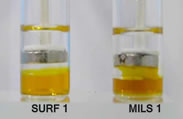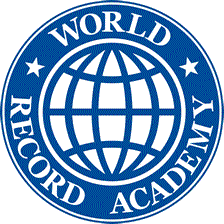Wednesday, February 1, 2012
First magnetic soap: Bristol University sets world record (Video)
BRISTOL, UK -- A team of international scientists, led by Bristol University Professor of Chemistry Julian Eastoe, created a liquid soap containing iron atoms which help form tiny particles; it could revolutionize the clean-up of dangerous oil spills because t's the first cleaning surfactant that responds to magnets , setting the world record for the First magnetic soap, according to World Record Academy (www.worldrecordacademy.com).

Photo: Scientists from Bristol University have developed a soap, composed of iron rich salts dissolved in water, that responds to a magnetic field when placed in solution. The soap's magnetic properties were proved with neutrons at the Institut Laue-Langevin to result from tiny iron-rich clumps that sit within the watery solution. Introducing a magnet forces the magnetic soap (on bottom of test tube) to rise up through an less-dense organic compound. Photo: University of Bristol ( enlarge photo
)
The Guinness world record for the Largest superconducting magnet was set by The Barrel Toroid, which consists of eight magnet coils in an array 25 m long and 5 m wide. It weighs 100 tonnes.
Guinness World Records also recognized the world record for the largest ball of magnetic tape; it weighs 570 kg (1,256 lb) which measures 2.125 m (6 ft 11 in) in width by 2.030 m (6 ft 7 in) in height and was achieved by EMC at the Kings Place Gallery, York Way, London, in UK
.
Chemists at Bristol University create a magnetic surfactant by incorporating iron into the liquid's molecules. This raises all sorts of interesting possibilities for controlling the movement and flow of these liquids.
For long, researchers have been searching for a way to control soaps (or surfactants as they are known in industry) once they are in solution to increase the ability to dissolve oils in water and then remove them from a system.
The Bristol University team produced the magnetic soap by dissolving iron in a range of inert surfactant materials composed of chloride and bromide ions, very similar to those found in everyday mouthwash or fabric conditioner.
The addition of the iron creates metallic centres within the soap particles, say the scientists led by Julian Eastoe. To test its properties, the team introduced a magnet to a test tube containing their new soap lying beneath a less dense organic solution, the Angewandte Chemie journal reported.
When the magnet was introduced the iron-rich soap overcame both gravity and surface tension between the water and oil, to levitate through the organic solvent and reach the source of magnetic energy, proving its magnetic properties.
Once the surfactant was developed and shown to be magnetic, the scientists took it to Institut Laue-Langevin (ILL), the world's flagship centre for neutron science, to investigate the science behind its remarkable property.
The potential applications of magnetic surfactants are huge, say the scientists.
"From a commercial point of view, though these exact liquids aren't yet ready to appear in any household product, by proving that magnetic soaps can be developed, future work can reproduce the same phenomenon in more commercially viable liquids for a range of applications from water treatment to industrial cleaning products," Prof Eastoe said.
Related world records:
Smallest steam engine: German scientists sets world record
Lightest material: Ultralight Metallic Microlattice sets world record (Video)
Largest Flashlight: Germany (HD Video)
Largest hi-fi system: AeroDream ONE sets world record (Video)
Most powerful handheld laser: Wicked Lasers (Video)
Oldest Light Bulb:
Livermore firehouse light (Video)
Fastest robot to solve a Rubik's Cube: Robot Ruby (Video)
Largest Rube Goldberg machine: Purdue University (Video)
Most Advanced Humanoid Robot: ASIMO
Smallest Christmas card: University of Glasgow
Oldest working electric hairdryer: British hairdryer
Largest
Tidal Turbine: AK1000
Smallest
1080p HD image sensor:
OmniVision
Smallest
Telemedicine Microscope:
CNSI
Smallest
Digital Camcorder: Muvi Atom
Thinnest
on-Wall Speaker: Mytos XTR-50
Fastest
ultraportable laptop: X201 ThinkPad
Largest
iPod: Jonathan Ive
Largest
3D Plasma Display: Panasonic
Most
patents by a university: Far East University Taiwan
Wednesday, February 1, 2012
| |
